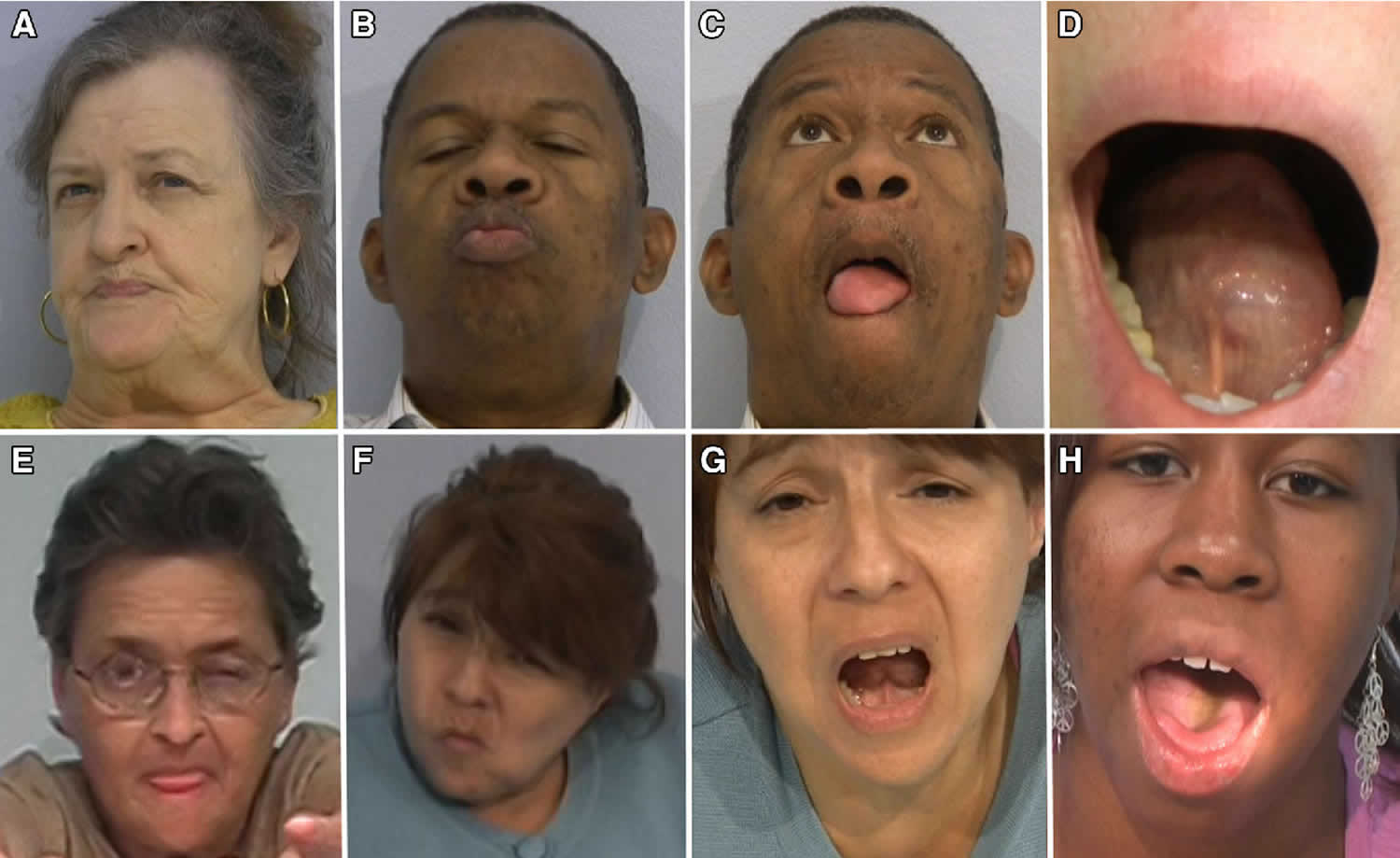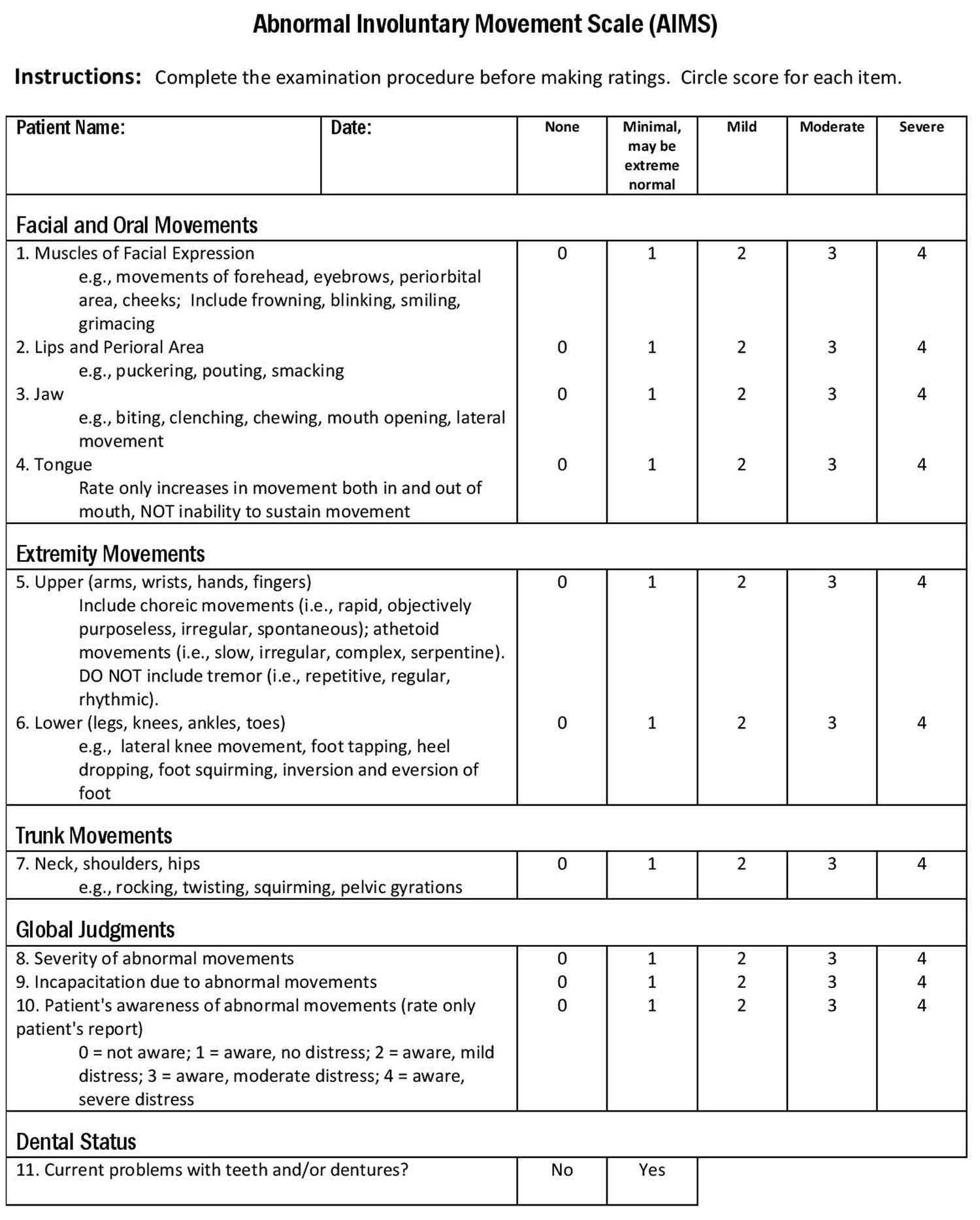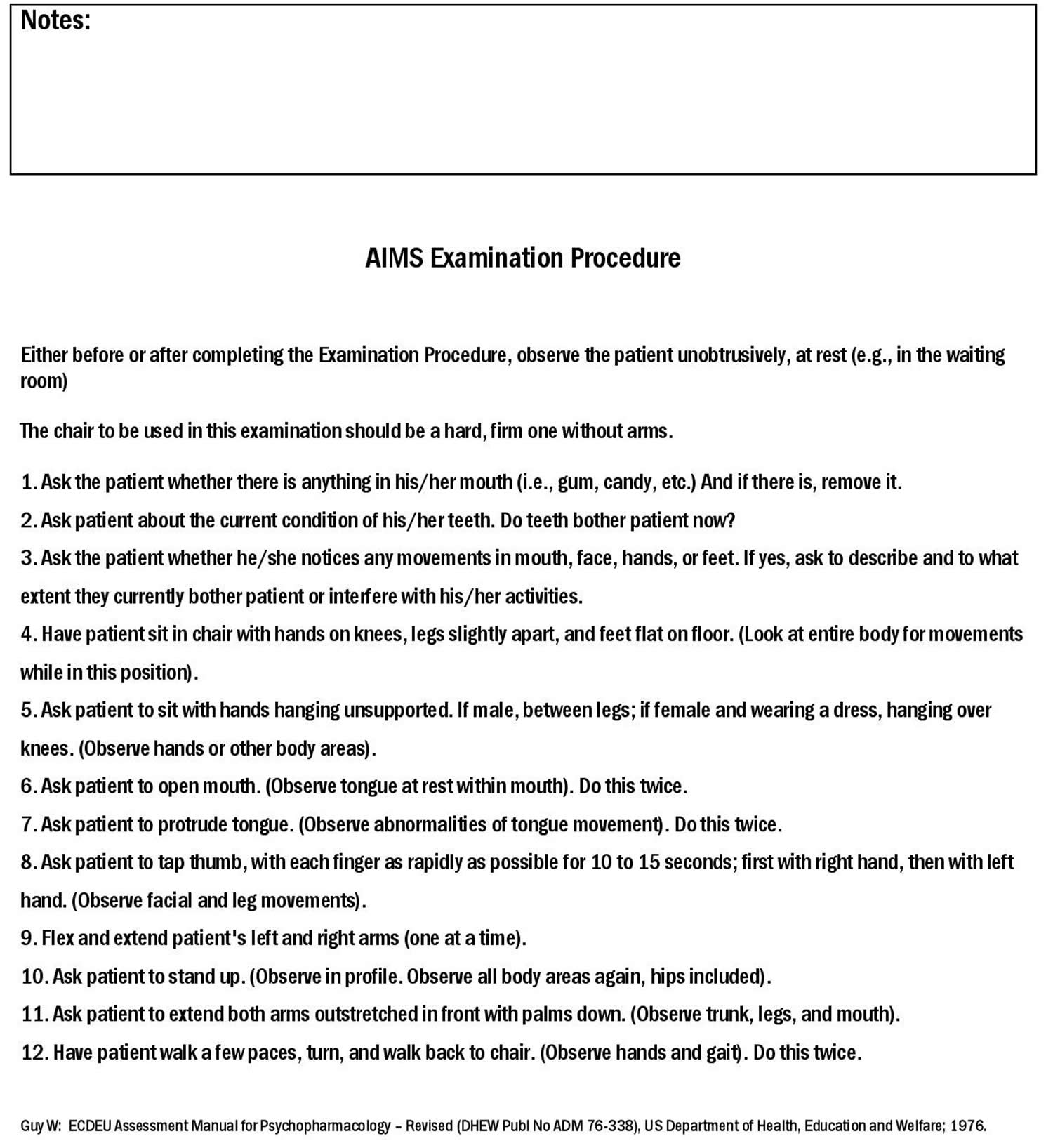Contents
What is tardive dyskinesia
Tardive dyskinesia is a serious side effect that may occur with long-term use of certain medications (neuroleptic drugs) used to treat mental illness. Tardive dyskinesia may appear as repetitive and involuntary jerking movements such as grimacing, eye blinking and other movements that occur in the face, neck, and tongue. The symptoms of tardive dyskinesia can be very troubling for patients and family members. The muscle movements are outside of the patient’s control.
Symptoms of tardive dyskinesia may include:
- Facial grimacing
- Finger movement
- Jaw swinging
- Repetitive chewing
- Tongue thrusting
Long-term use of medications called antipsychotics can cause tardive dyskinesia. Some medications used for nausea can also cause tardive dyskinesia. The symptoms of tardive dyskinesia might continue even when the medication is stopped. About one in four patients who receive long-term treatment with an antipsychotic will experience tardive dyskinesia.
A high percentage of schizophrenic people who have spent long periods of time taking these drugs have a high risk of developing tardive dyskinesia. However, neuroleptic drugs are also prescribed for depression, some digestive disorders, and other neurologic illnesses.
Anyone taking an antipsychotic may develop tardive dyskinesia, but certain factors increase the risk such as:
- being elderly
- being female
- having diabetes
- having other mental illnesses
It is important to remember that tardive dyskinesia usually happens after taking antipsychotics for a long time. Some patients may have tardive dyskinesia after 3 months, but many develop tardive dyskinesia after several years of treatment. tardive dyskinesia is unlikely to occur if an antipsychotic is only taken for a few weeks.
When tardive dyskinesia is diagnosed, the health care provider will either have you stop the medicine or switch to another one. If tardive dyskinesia is mild or moderate, various medicines may be tried. Your provider can tell you more about these.
If tardive dyskinesia is very severe, a procedure called deep brain stimulation (DBS) may be tried. Deep brain stimulation uses a device called a neurostimulator to deliver electrical signals to the areas of the brain that control movement.
Remember, tardive dyskinesia is a serious side effect that can be caused by long-term use of certain medications used to treat mental illness. While these
medications are often necessary to treat mental illness, it is important that patients, family, and caregivers are aware of the signs and symptoms of tardive dyskinesia so that it can be monitored and treated early.
How to reverse tardive dyskinesia?
If diagnosed early, tardive dyskinesia may be reversed by stopping the drug that caused the symptoms. Even if the drug is stopped, the involuntary movements may become permanent, and in some cases, may become worse.
Patients taking long-term antipsychotics should be closely followed by their doctor. Their doctor can perform tests to see if a patient has signs of tardive dyskinesia or if tardive dyskinesia is improving. These tests should be done routinely at office visits because recognizing tardive dyskinesia early may reduce the severity of the side effect.
Tardive dyskinesia causes
Tardive dyskinesia is caused by long-term use of a class of drugs known as neuroleptics. These drugs are also called antipsychotics or major tranquilizers. Neuroleptic drugs are often prescribed for management of certain mental, neurological, or gastrointestinal disorders.
Neuroleptic drugs block dopamine receptors in the brain. Dopamine is a neurotransmitter which is a chemical that helps brain cells to communicate. Although most cases occur after a person has taken these drugs for several years, some cases may occur with shorter use, as little as 6 weeks, of neuroleptic drugs.
Metoclopramide and prochlorperazine are drugs used for chronic gastrointestinal conditions that may cause tardive dyskinesia.
Drugs that with the potential to cause tardive dyskinesia:
- Aripiprazole (Abilify)
- Benzisothiazole (ziprasidone)
- Benzisoxazole (iloperidone)
- Butyrophenones (haloperidol, droperidol)
- Calcium channel blockers (flunarizine, cinnarizine)
- Chlorpromazine (Thorazine)
- Dibenzazepine (loxapine, asenapine)
- Dibenzodiazepine (clozapine, quetiapine)
- Diphenylbutylpiperidine (pimozide)
- Fluphenazine (Prolixin)
- Haloperidol (Haldol)
- Indolones (molindone)
- Lithium
- Olanzapine (Zyprexa)
- Perphenazine (Trilafon)
- Phenothiazines (chlorpromazine, triflupromazine, thioridazine, mesoridazine, trifluoperazine, prochlorperazine, perphenazine, fluphenazine, perazine)
- Pyrimidinone (risperidone, paliperidone)
- Prochlorperazine
- Quinolinone (aripiprazole)
- Risperidone (Risperdal)
- Substitute benzamides (metoclopramide, tiapride, sulpiride, clebopride, remoxipride, veralipride, amisulpride, levosulpiride)
- Serotonin reuptake or serotonin norepinephrine reuptake inhibitors (duloxetine, citalopram)
- Thienobenzodiazepine (olanzapine)
- Thioridazine
- Thioxanthenes (chlorprothixene, thiothixene)
- Tricyclic antidepressants (amoxapine)
- Trifluoperazine
- Ziprasidone (Geodon)
Newer antipsychotics seem less likely to cause tardive dyskinesia, but they are not entirely without risk.
Other drugs that can cause tardive dyskinesia include:
- Metoclopramide (treats stomach problem called gastroparesis)
- Antidepressant drugs such as amitriptyline, fluoxetine, phenelzine, sertraline, trazodone
- Antiparkinson drugs such as levodopa
- Antiseizure drugs such as phenobarbital and phenytoin
Tardive dyskinesia vs Dystonia
Dystonia is a condition with sustained involuntary muscle contractions with twisting, repetitive movements. Dystonia may affect the entire body (generalized dystonia) or one part of the body (focal dystonia).
Dystonia is characterized by persistent or intermittent muscle contractions causing abnormal, often repetitive, movements, postures, or both. The movements are usually patterned and twisting, and may resemble a tremor. Dystonia is often initiated or worsened by voluntary movements, and symptoms may “overflow” into adjacent muscles.
Dystonia is classified by:
- Clinical characteristics (including age of onset, body distribution, nature of the symptoms, and associated features such as additional movement disorders or neurological symptoms) and
- Cause (which includes changes or damage to the nervous system and inheritance). Doctors use these classifications to guide diagnosis and treatment.
There are multiple forms of dystonia, and dozens of diseases and conditions may include dystonia as a symptom. Dystonia may affect a single body area or be generalized throughout multiple muscle groups. Dystonia affects men, women, and children of all ages and backgrounds. Estimates suggest that no fewer than 300,000 people are affected in the United States and Canada alone. Dystonia causes varying degrees of disability and pain, from mild to severe. There is not yet a cure, but multiple treatment options exist and scientists around the world are actively pursuing research toward new therapies.
Although there are several forms of dystonia and the symptoms may outwardly appear quite different, the element that all forms share is the repetitive, patterned, and often twisting involuntary muscle contractions. Dystonia is a chronic disorder, but the vast majority of dystonias do not impact cognition, intelligence, or shorten a person’s life span.
Forms of dystonia include 1:
- Focal dystonias – Affecting a specific group of muscles or body part:
- Blepharospasm: Dystonia that affects the muscles of the eyelids and brow.
- Cervical dystonia (spasmodic torticollis): Dystonia that affects the neck and sometimes the shoulders.
- Oromandibular dystonia (cranial dystonia): Symptoms include forceful contractions of the face, jaw, and/or tongue.
- Spasmodic dysphonia (laryngeal dystonia): Dystonia that affects the vocal cords.
- Hand dystonia (writer’s cramp): Dystonia of the fingers, hand, and/or forearm.
- Lower limb dystonia: Dystonia of the leg, foot, and/or toes.
- Musicians’ dystonias (task-specific)
- Generalized dystonia: Generalized dystonia is characterized by twisting of the limbs and torso.
- Dopa-responsive dystonia: A group of dystonias that respond to a medication called levodopa.
- Myoclonus dystonia: A hereditary form of dystonia that includes prominent myoclonus symptoms.
- Paroxysmal dystonias and dyskinesias: Episodic movement disorders in which abnormal movements occur only during attacks.
- X-linked dystonia-parkinsonism: A hereditary form of dystonia that includes symptoms of parkinsonism.
- Rapid-onset dystonia-parkinsonism: A hereditary form of dystonia that includes symptoms of parkinsonism.
- Secondary dystonias: Dystonia that is triggered by factors such as trauma, medication exposure, toxins.
- Trauma: Dystonia may follow trauma to the head and/or to a specific body area.
- Drug-induced (Tardive dystonia & dyskinesias): Specific drugs are capable of causing dystonia.
- Toxins: Several rare toxins are known to cause movement disorders.
- Neurological and metabolic disorders: Dystonia can occur as a symptom of multiple disorders.
- Functional (psychogenic) dystonia: Dystonia that is secondary to a combination of neurological and psychiatric/psychological causes.
To accurately describe the form or type of dystonia that an individual has, at least four specific pieces of information must be accounted for:
- The age at which the symptoms started.
The age at which symptoms begin is referred to as age of onset. If an individual develops symptoms prior to approximately age 30, it may be referred to as early-onset or childhood-onset. (If the dystonia occurs during the teen years, the term adolescent-onset may be used.)
If symptoms develop after the age of 30, it is called late-onset or adult-onset.
- How the body is affected.
Dystonia is also classified anatomically. When dystonia affects only one part of the body, it is called focal dystonia.
Segmental dystonia affects two or more connected body areas (for example the neck, shoulder, and arm). If two or more areas in different parts of the body are affected, the dystonia is termed multifocal(for example the eyes and vocal cords).
Generalized dystonia refers to dystonia that may affect the limbs, trunk, and other major body areas simultaneously. The term axial dystonia describes dystonia that specifically affects the torso.
When dystonia only affects muscles on one side of the body, it is called hemidystonia
Certain dystonias are labeled task-specific which means that the symptoms occur only when the person is performing a specific task or movement. These forms often involve the fingers and hands or the mouth.
If symptoms only occur in “episodes” that last for minutes or hours, the terms paroxysmal dystonia and dyskinesias are used.
The word torsion is sometimes used, usually in reference to generalized, axial, or segmental dystonia. Torsion refers to the twisting element of dystonia. It describes muscles contracting against each other.
- What is known about the cause.
Categorizing dystonia by the cause is not a simple task and can easily get complicated. The DMRF often states in publications that we don’t know the cause of dystonia because scientists have not yet identified the precise biochemical process in the body that triggers the symptoms. This is often referred to as the “mechanism” of dystonia, and it is suspected that this mechanism is common to all forms of dystonia.
On the other hand, we do know that dystonia can occur as a result of trauma, certain medications, and mutated genes. So, we may say that the mutated DYT1 gene or physical trauma cause dystonia, but these explanations do not address the true origin of the dystonia and what happens inside the body to produce the symptoms.
When describing dystonia by the cause, it may be characterized as primary, secondary, or dystonia-plus.
- If the dystonia occurs with symptoms of additional neurological disorders.
Dystonia can be associated with numerous diseases and conditions. These include specific vascular conditions, infections, brain tumors, metabolic conditions, neurodenegerative disorders, demylianating disorders, and structural conditions.
The classifications above are necessary needed to set the best course for treatment, but for the sake of routine conversation, most people use the terms that describe the most prominent feature of the dystonia (for example, cervical dystonia for dystonia that affects the neck and shoulders; dopa-responsive dystonia for the form of childhood-onset dystonia that has characteristics that resemble parkinsonism).
How is dystonia diagnosed?
At this time, there is no single test to confirm the diagnosis of dystonia. Instead, the diagnosis rests in a physician’s ability to observe symptoms of dystonia and obtain a thorough patient history. In order to correctly diagnose dystonia, doctors must be able to recognize the physical signs and be familiar with the symptoms. In certain instances, tests may be ordered to rule out other conditions or disorders. The kind of specialist who typically has the training to diagnose and treat dystonia is a movement disorder neurologist.
The dystonia diagnostic process may include:
- Patient history
- Family history
- Laboratory studies such as blood and urine tests, and analysis of cerebrospinal fluid
- Electrical recording techniques, such as electromyography (EMG) or electroencephalography (EEG)
- Genetic testing for specific forms of dystonia
- Other tests and screenings intended to rule out other conditions or disorders
Individuals with dystonia may be concerned that their children are at risk of inheriting the disorder. There are forms of dystonia that are known to be genetic and forms that may or may not have a genetic component—researchers cannot confirm or rule it out at this time. More than 200 genes have been linked to dystonia.
A genetic counselor can help individuals and families learn about the genetics of dystonia and whether they are eligible for genetic testing. Researchers are actively seeking to better understand the genetics of all dystonias and to identify dystonia-causing genes.
Tardive dyskinesia symptoms
Tardive dyskinesia is characterized by involuntary and abnormal movements of the jaw, lips and tongue. Typical symptoms include facial grimacing, sticking out the tongue, sucking or fish-like movements of the mouth. In some cases, the arms and/or legs may also be affected by involuntary rapid, jerking movements (chorea), or slow, writhing movements (athetosis). Symptoms of tardive dystonia include slower, twisting movements of larger muscles of the neck and trunk as well as the face.
Features of tardive dyskinesia:
- Lip smacking
- Sticking tongue out
- Making funny faces
- Jerking hand and leg movements
- Neck twisting
Tardive dyskinesia can be measured with Abnormal Involuntary Movement Scale (AIMS) 2, a 12-item scale with items 1–7 assessing involuntary movements across body regions, with a score ranging from 0 (no dyskinesia) to 4 (severe, maximal amplitude, and persistence during observation of abnormal movements), or with other less frequently used instruments/scales, such as the Extrapyramidal Symptom Rating Scale 3.
Figure 1. Abnormal Involuntary Movement Scale (AIMS)
[Source 2]Tardive dyskinesia treatment
The treatment for tardive dyskinesia varies from person to person. Treatment of tardive dyskinesia initially consists of discontinuing the neuroleptic drug as soon as involuntary facial, neck, trunk, or extremity movements are identified in people taking neuroleptic drugs if this is felt to be safe psychiatrically. In people with severe psychiatric conditions, this may not be an option, although the neuroleptic drug can sometimes be replaced with an alternative medication. Use of an “atypical” neuroleptic drug is often used in place of traditional neuroleptics if felt to be psychiatrically appropriate. However, the “atypical” neuroleptic drugs are also capable of causing or perpetuating tardive dyskinesia. In some cases, physicians may be forced to reinstitute a neuroleptic drug if the tardive dyskinesia symptoms do not disappear and become very severe after medication is discontinued. Many patients require long term use of antipsychotic medication to treat ongoing mental illness.
Once tardive dyskinesia develops, some effects may be permanent or take a long time to go away.
Other drugs such as benzodiazepines, clozapine, or botulinum toxin (Botox) injections also may be tried 4.
New medications have been developed for tardive dyskinesia, but may be too expensive for many patients.
- In 2017, Ingrezza (valbenazine) was FDA approved to treat adults with tardive dyskinesia. Ingrezza is manufactured by Neurocrine Biosciences, Inc.
- In 2017, Austedo (deutetrabenazine) was FDA approved for the treatment of tardive dyskinesia in adults. Austedo is manufactured by Teva Pharmaceutical Industries Ltd.
Deutetrabenazine and valbenazine are FDA approved for tardive dyskinesia and have at present the best high-quality evidence supporting their efficacy for tardive dyskinesia, at the dose of 24–36 mg/day for deutetrabenazine and 40–80 mg/day for valbenazine, likely with a positive dose–response relationship 5. Moreover, the efficacy seems to progress further beyond the acute 6–12 weeks, as treatment continues for up to 1 year, both in patients with schizophrenia or schizoaffective disorder and in patients with mood disorders. Both deutetrabenazine and valbenazine are safe, at least in the studied, psychiatrically stable patient populations, and according to meta-analytic results, neither of the 2 agents seems to have an increased risk for depression or suicidality in stable patients with tardive dyskinesia 6.
Tetrabenazine has no high-quality evidence for its efficacy or safety in patients with tardive dyskinesia 5 and should, at best, be considered a third-line, off-label treatment for tardive dyskinesia, unless until methodologically sound trials, ideally comparing tetrabenazine with other VMAT-2 inhibitors, show its evental non-inferiority regarding effiacy and tolerability compared with deutetrabenazine and valbenazine 5.
In addition to these approved medications, other alternative agents have shown mild benefit in treating tardive dyskinesia, such as branched-chain amino acids, ginkgo biloba 7, vitamin E 8 or melatonin 9, but without definitive, large/high-quality trials to support their clinical use.
Choline, lithium, bromocriptine, baclofen, methyldopa, valproate, clonidine, propranolol, amantadine, clonazepam, and nifedipine have occasionally been helpful but in most cases do not improve tardive dyskinesia 10. Tetrabenazine is often useful for symptomatic treatment of tardive dyskinesia and is currently available for use in the US. However, it carries the risk of causing or aggravating depression. Other experimental drugs are being tested to reduce or eliminate the symptoms of tardive dyskinesia 10.
- Forms of Dystonia. https://www.dystonia-foundation.org/what-is-dystonia/forms-of-dystonia[↩]
- Guy W. Abnormal Involuntary Movement Scale (117-AIMS), in ECDEU Assessment Manual for Psychopharmacology. 1976. https://mmcp.health.maryland.gov/pap/docs/Abnormal%20Involuntary%20Movement%20Scale.pdf[↩][↩]
- Manual for the Extrapyramidal Symptom Rating Scale (ESRS). Chouinard G, Margolese HC. Schizophr Res. 2005 Jul 15; 76(2-3):247-65. https://www.ncbi.nlm.nih.gov/pubmed/15949657/[↩]
- Tardive Dyskinesia. https://emedicine.medscape.com/article/1151826-overview#a1[↩]
- Solmi M, Pigato G, Kane JM, Correll CU. Treatment of tardive dyskinesia with VMAT-2 inhibitors: a systematic review and meta-analysis of randomized controlled trials. Drug Design, Development and Therapy. 2018;12:1215-1238. doi:10.2147/DDDT.S133205. https://www.ncbi.nlm.nih.gov/pmc/articles/PMC5958944/[↩][↩][↩]
- Davis MC, Miller BJ, Kalsi JK, Birkner T, Mathis MV. Efficient trial design – FDA approval of valbenazine for tardive dyskinesia. N Engl J Med. 2017;376(26):2503–2506.[↩]
- Zheng W, Xiang YQ, Ng CH, Ungvari GS, Chiu HF, Xiang YT. Extract of ginkgo biloba for tardive dyskinesia: meta-analysis of randomized controlled trials. Pharmacopsychiatry. 2016;49(3):107–111. https://www.ncbi.nlm.nih.gov/pubmed/26979525[↩]
- Soares-Weiser K, Maayan N, McGrath J. Vitamin E for neuroleptic-induced tardive dyskinesia. Cochrane Database Syst Rev. 2011;2:CD000209 https://www.ncbi.nlm.nih.gov/pubmed/21328246[↩]
- Richardson MA, Small AM, Read LL, Chao HM, Clelland JD. Branched chain amino acid treatment of tardive dyskinesia in children and adolescents. J Clin Psychiatry. 2004;65(1):92–96. https://www.ncbi.nlm.nih.gov/pubmed/14744176[↩]
- Tardive Dyskinesia. https://rarediseases.org/rare-diseases/tardive-dyskinesia/[↩][↩]







